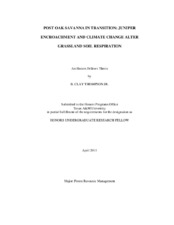| dc.description.abstract | The amount of carbon flux from soils on a global scale is estimated at over 75 x 1015 g C yr-1. Climate change is projected to affect regional environmental conditions, raising temperatures and altering precipitation patterns. The semi-arid environment of the post oak savannah is an ecotone in transition. As juniper encroachment replaces native grasses, changes in species composition may affect carbon cycling. Given that water is limiting in this warm-temperate climate, changing precipitation patterns coupled with higher temperatures may alter function in addition to the structure of savanna ecosystems. The Texas Warming and Rainfall Manipulation (Texas WaRM) experiment is designed to test global climate change factors and the responses of the dominant tree, eastern red cedar (Juniperus virginiana) and grass species, little blue stem (Schizachyrium scoparium). We compared respiratory carbon losses of soils between eastern red cedar and little blue stem plots subjected to warming (1.5 °C) and summer drought treatments to determine the effects of climate change on integrated below-ground CO2 efflux. During the June to August months, soil CO2 efflux rates were determined and compared among treatments in relation to soil temperature and moisture. Overall, juniper and grass plots had relatively equal CO2 respiratory flux, although it generally has more associated roots and microbial biomass. Soil respiration in grass plots appeared more responsive to changes in soil moisture, while juniper maintained more consistent respiration under increasing heat and declining moisture conditions during summer drought. With equivalent soil CO2 efflux and reduced responsiveness to warming or drought, coupled with increased woody biomass, juniper encroachment might have positive effects on the carbon cycle of this transitional biome through increased carbon sequestration. Determining these transitional characteristics of a changing carbon budget will aid in projecting climate change impacts on carbon cycling and provide management options for native and managed vegetation. | en |


